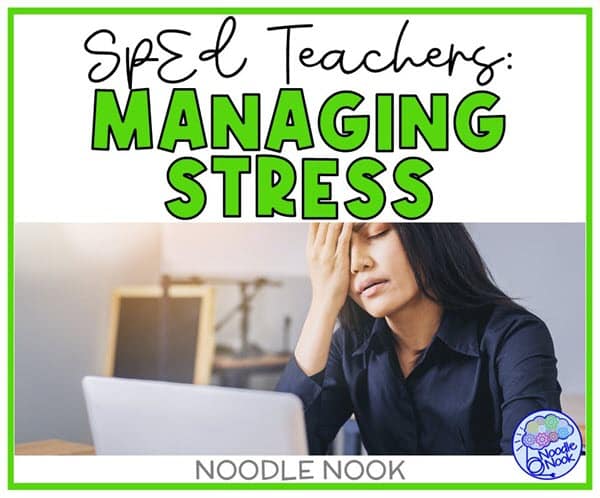How to Manage Teacher Stress and Reduce Burnout on Your Campus
There is one thing we can all agree on; teacher stress is high and we’re burning out. There are the demands to make up for lost time, the social emotional deficits that are making teaching that much harder, plus the everyday stress that was already a part of teaching. It’s pretty bad. Anxiety, depression, exhaustion, and burnout, that’s where we’re all at. We’re all wondering how to manage teacher stress.
If you’re an administrator or campus leader, you are feeling stressed too, but your stress is probably about managing your teacher’s stress. When teachers feel stressed out or overwhelmed, they are more likely to leave the classroom. That means as administration, having to rehire, retrain, and rebuild your staff. And that is even more stressful.
So, what can you do to manage stress and reduce teacher burnout on your campus, especially with special education teachers, which are always in short supply?
Why Teacher Stress Management is Important at Your School
When a teacher is effective in the classroom, they have classroom management. They’ve built a positive classroom culture. They have an effective team of paraprofessionals and partner teachers. Most importantly, their students are learning. That positively impacts the staff, the students, their families, and the community.
Yes, that’s how important our jobs are. What we do has a direct impact on the greater community. And that impact is long felt. What we do changes the future workforce capacity, the earning potential of families, and the overall safety and success of our neighborhoods. Needless to say, it’s critical to manage teacher stress in order to improve student lives as well as the greater community.
9 Ways to Manage Teacher Stress
How do you actually make that happen? How do you manage teacher stress as a campus leader? Well, there are 9 ways to manage stress and reduce teacher burnout.
1. Target Classroom Management
Kids today.
That’s something teachers have been saying for ages. ‘Kids today.’
But, seriously, kids today. They are not like the cherubs that sat before us 5, 10 and 20 years ago.
Granted, hindsight is 20/20. We’re all looking at former classrooms with rose colored glasses, but there is something to this. Students now are different than before. They’ve missed huge chunks of in-person classes. They had to learn virtually. They’ve missed essential social learning. Plus, they’re also dealing with stress of a different kind. So, what do we do?
What works for classroom management today may not be from the pages of Harry Wong. In order for teachers to better manage students, they need to incorporate technology, add time for mental health and wellness, work on social communication and interactions, and, oh yeah, teach the curriculum in an engaging and relevant way.
This will not happen by itself.
If you’re campus leadership, consider how to support teachers in each of these ways. This can help staff as they strive for better classroom management. That’ll likely include targeted professional development after extensive observations to pinpoint areas of need.
2. Make Time
When you feel heard, you’re less anxious. As a campus leader, that means making time. Time for answering questions. Time for talking with, not just at, individual staff members. Time to ask questions and get second-tier information… you know, the stuff that doesn’t show up in reports and test scores.
Establishing a culture of communication with the understanding that you have time for your team makes their task of dealing with stress much easier.
And, as a sidebar, on the topic of asking questions from staff or team members, be careful about your wording. Try to avoid asking questions that allow a teacher to focus on the negative. Ask questions in a way that prompts them to tell their solution.
Questions that set up not only focusing on the issue at hand but also the path to resolution. When your team knows you’ll always ask them for the problem and solution, it forces them to problem solve. They have to come up with options before them come to you. From there, ask them what they think will help them solve the problem most effectively. Finally, do your best to support their resolution.
3. Share Performance Expectations Early
There is nothing worse than finding out late in the game that everyone was playing Catan and you were playing Pie Face. Part of helping your staff not feel overwhelmed and stressed out is to set expectations early. This makes it clear what standards individual members will be held to.
I love doing classroom observations. I can tell in 30 seconds what’s going on. If you’ve been working as instructional leadership or administration for any amount of time, I know you know what I know… You Just Know!
Here’s what I also know. I focus on special education. When observations happen for special education teachers, folks are less sure of what they’re supposed to see. They look around and if all the students are alive and no one has fallen out of their wheelchair, they smile, say ‘bless their hearts’, and scamper to the next classroom.
In order to set expectations for staff early so they can reach them, sometimes that means you have to get a better idea of what your expectations are. If special ed isn’t your specialty, you might be wondering what to look for inside special education classrooms, specifically for students with low-incidence disabilities or the severely and profoundly disabled.
Check out this course to get a better idea of what you should be seeing and looking for. This will help you set expectations for your teachers and keep them from stressing out.
4. Provide Prep Time
As a teacher, prepping for school to start seems like equal parts ‘I need to be in my classroom’ and ‘they need me at this thing that’s not in my classroom’. That feeling in the time leading up to school starting is how the stress starts. Truth is, teachers need more time than they have in an instructional day. That means work goes home, hours run late, and stress starts ticking up.
Now, unless you have some magical witchcraft that can stop time and help us all get more done, then there’s got to be another way. That, more often than not, is by being more mindful of a teacher’s time. Before school make sure to allow ample time in the classroom to prepare. During the school year, try not to take prep time or conference periods without ample warning so a teacher has the head’s up. Keep after school meetings to a reasonable length so teachers can get home to their families at a reasonable hour. Also, have flexibility in how you hold meetings, conduct PD and even do conferences.
Hear me out. With the widespread use and acceptance of video conferencing over the past several years, now that we’re in person, it can feel like we can leave that all behind. But do we? Consider all the ways those tools can support digital coaching. On top of that, there are some staff meetings that you can hold by videoconferencing. Face it, with all your teachers in the cafeteria, they may be physically present, but 70% of them are completely checked out. Why not hold it by video where teachers can be working in their room and participating in the meeting at the same time? I know, you may not have their full attention, but that’s the case whether you’re in person or by video. The point here is to consider other options that allow teachers the time they need to prepare for instruction.
5. Mentorship
Having a mentor is one of the most impactful things you can do to boost morale and tamper stress. This rings true for all teachers, but is critical for new teachers, teachers that are changing content or assignments, and teachers that are new to a building.
When we have someone to check with, ask questions, and build a general sense of comradery, it helps to build teacher confidence. It also helps to connect the teacher to someone who can help them deal with all the parts of the job. Believe me, spouses, roommates, and pets at home would love their teacher to have someone else to talk things out with other than them.
Develop and promote mentorship on your campus. For teachers without an equivalent in house, like special ed teachers who are sometimes the only one on their campus working with a specific population, consider cross-campus mentorship. These connections allow for critical and specific concerns and supports to be provided that are relevant to the population and teacher’s everyday instruction.
Either way, mentorship has a positive impact on teacher performance. It can also help to lessen stress as well as build interpersonal connections.
6. Teambuilding
As a campus administrator, you have a ton of team-building exercises you’ve participated in and used over the years. Somehow, when time is tight and the to-do list is long, we skip this part of things.
Don’t.
Team building is critical for connecting individuals to not only better support one another, but better support students. What’s more, when a team is connected and works more cohesively, they boost their own morale and also solve their own problems. Conversely, when a team is not bonded, they are more difficult to manage, harder to focus on, and have more problems you have to deal with.
Don’t skip the team building.
7. Make Meetings Zen
Okay, some of you are reading this like, ‘ummm… no’.
I get it.
This idea of Zen may be a little too humpf. Let’s follow the science though. At your next meeting, consider one of these three things. First, start with one minute of silent reflection. Yeah. Just one minute can help people destress, center themselves, and mentally prepare for what’s coming. With everyone always running at breakneck speeds, one minute of calm can do wonders to help tamper stress.
Second, try closing with one minute of deep breathing. Again, one minute can actually impact stress, anxiety, and frustration. As you close out, Zen out with some deep breaths.
Third, pick an affirmation at the start of a meeting. Ask participants to pick from a menu of affirmations and read them aloud before starting. Hearing some positivity can help lower stress, boost self-esteem, and start a meeting on a more productive and encouraging footing. Choose one of these three ways to make your next meeting Zen and see if it changes things at all. If you need a bank of affirmations, click here to snag these.
8. Campus Wide Tap Out
The copying machine wasn’t working at lunch, my lesson plans are totally off, I missed my lunch and this student is pulling on my last nerve like a string from a sweater… I’m unraveling! HELP!
Ever had a moment like that? As an administrator, we know that moment can end badly. I know I wish some campuses I’ve supported had implemented a tap out. What is that? A tap out on a school campus is a system where, when a teacher needs a minute to step away, gather their thoughts, or cry without anyone seeing, there is a way to get it.
Some campuses have implemented a way to call into the office, say the tap-out phrase, and someone is dispatched to the teacher’s classroom to cover them for 2-4 minutes. This tap-out can save the sanity of a teacher on the edge, but, as an administrator, it can be an intervention that prevents something bad from happening.
9. Teach Your Team
I cannot tell you the importance of quality professional development for teachers. What is also important is meaningful and effective professional development for the support staff that’s in the classroom every day helping students. That team can make or break your special ed teachers.
When you put together a team that’s better prepared with great training topics that actually impact classroom practices, that team is more cohesive and supportive. All this directly allows you to manage teacher stress and improve retention.
If you’re looking for quality special education training for educators teaching students with complex access needs, check out the library of topics available here.
What Now?
How schools support stressed out teachers depends on them. With these 9 ways to manage teacher stress and burnout on your campus, an administrator has some options as to how to proceed. Ultimately, what you choose to do will depend on you, but do something. There is nothing worse than turning over staff and losing good teachers. In order to prevent burnout, target these ways to reduce teacher stress on your campus.









